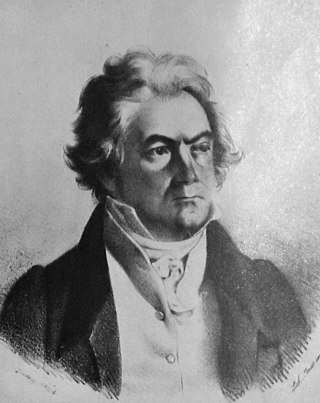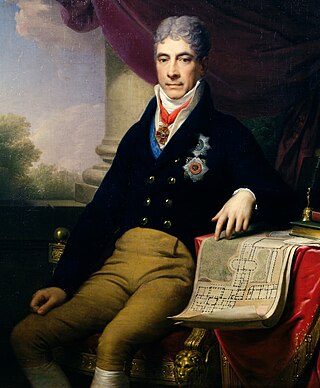Related Research Articles

Ludwig van Beethoven was a German composer and pianist. He is one of the most revered figures in the history of Western music; his works rank among the most performed of the classical music repertoire and span the transition from the Classical period to the Romantic era in classical music. Beethoven's career has conventionally been divided into early, middle, and late periods. His early period, during which he forged his craft, is typically considered to have lasted until 1802. From 1802 to around 1812, his middle period showed an individual development from the styles of Joseph Haydn and Wolfgang Amadeus Mozart, and is sometimes characterized as heroic. During this time, he began to grow increasingly deaf. In his late period, from 1812 to 1827, he extended his innovations in musical form and expression.
In music, the opus number is the "work number" that is assigned to a musical composition, or to a set of compositions, to indicate the chronological order of the composer's publication of that work. Opus numbers are used to distinguish among compositions with similar titles; the word is abbreviated as "Op." for a single work, or "Opp." when referring to more than one work. Opus numbers do not necessarily indicate chronological order of composition. For example, posthumous publications of a composer's juvenilia are often numbered after other works, even though they may be some of the composer's first completed works.

Ludwig van Beethoven's Bagatelles, Op. 126 for solo piano were published late in his career, in the year 1825. Beethoven dedicated them to his brother Nikolaus Johann van Beethoven (1776–1848), and wrote to his publisher, Schott Music, that the Opus 126 Bagatelles "are probably the best I've written".
Ludwig van Beethoven's Op. 18, published in 1801 by T. Mollo et Comp in Vienna in two books of three quartets each, comprised his first six string quartets. They were composed between 1798 and 1800 to fulfill a commission for Prince Joseph Franz Maximilian Lobkowitz, who was the employer of Beethoven's friend, the violinist Karl Amenda. They are thought to demonstrate his total mastery of the classical string quartet as developed by Joseph Haydn and Wolfgang Amadeus Mozart. The order of publication does not correspond to the order of composition. Beethoven composed these quartets in the sequence 3, 1, 2, 5, 4, 6. See:

The String Quartet No. 1 in F major, Op. 18, No. 1, was written by Ludwig van Beethoven between 1798 and 1800, published in 1801, dedicated to the Bohemian aristocrat Joseph Franz von Lobkowitz. It is actually the second string quartet that Beethoven composed.

The String Quartet No. 6 in B-flat major, Op. 18, No. 6, was written between 1798 and 1800 by Ludwig van Beethoven and published in 1801, and dedicated to Joseph Franz von Lobkowitz.

Count Andrey Kirillovich Razumovsky was a Russian Imperial diplomat who spent many years of his life in Vienna. His name is transliterated differently in different English sources, including spellings Razumovsky, Rasumofsky, and Rasoumoffsky.

The String Quartet No. 7 in F major, Op. 59, No. 1, was written by Ludwig van Beethoven and published in 1808. This work is the first of three of his "Rasumovsky" cycle of string quartets.

Ludwig van Beethoven is one of the most influential figures in the history of classical music. Since his lifetime, when he was "universally accepted as the greatest living composer", Beethoven's music has remained among the most performed, discussed and reviewed in the Western world. Scholarly journals are devoted to analysis of his life and work. He has been the subject of numerous biographies and monographs, and his music was the driving force behind the development of Schenkerian analysis. He is widely considered among the most important composers, and along with Bach and Mozart, his music is the most frequently recorded.

The String Quartet No. 8 in E minor, Op. 59, No. 2, was written by Ludwig van Beethoven and published in 1808. This work is the second of three of his "Rasumovsky" cycle of string quartets, and is a product of his "middle" period.

The String Quartet No. 9 in C major, Op. 59, No. 3, was written by Ludwig van Beethoven and published in 1808. This work is the third of three of his "Razumovsky" cycle of string quartets, and is a product of his "middle" period. It consists of four movements:

Ludwig van Beethoven's String Quartet No. 10 in E-flat major, Op. 74, was written in 1809 and is nicknamed the "Harp" quartet.

Ludwig van Beethoven's Piano Sonata No. 30 in E major, Op. 109, composed in 1820, is the third-to-last of his piano sonatas. In it, after the huge Hammerklavier Sonata, Op. 106, Beethoven returns to a smaller scale and a more intimate character. It is dedicated to Maximiliane Brentano, the daughter of Beethoven's long-standing friend Antonie Brentano, for whom Beethoven had already composed the short Piano Trio in B♭ major WoO 39 in 1812. Musically, the work is characterised by a free and original approach to the traditional sonata form. Its focus is the third movement, a set of variations that interpret its theme in a wide variety of individual ways.
The String Quartet No. 2 in A minor, Op. 13, was composed by Felix Mendelssohn in 1827. Written when he was 18 years old, it was, despite its official number, Mendelssohn's first mature string quartet. One of Mendelssohn's most passionate works, the A minor Quartet is one of the earliest and most significant examples of cyclic form in music.
Wolfgang Amadeus Mozart (1756–1791) had a powerful influence on the works of Ludwig van Beethoven (1770–1827). Beethoven held Mozart in high regard; some of his music recalls Mozart's, he composed several variations on Mozart's themes and he modeled a number of his compositions on those of the older composer. Whether the two men ever actually met remains a matter of speculation among scholars.
Razumovsky is a Ukrainian-Russian noble family.
Lewis H. Lockwood is an American musicologist whose main fields are the music of the Italian Renaissance and the life and work of Ludwig van Beethoven. Joseph Kerman described him as "a leading musical scholar of the postwar generation, and the leading American authority on Beethoven".
The Schuppanzigh Quartet was a string quartet formed in Vienna in the 1790s by the violinist Ignaz Schuppanzigh. It continued, with breaks and changes of membership, for many years. Schuppanzigh was a close friend and admirer of Ludwig van Beethoven, and the quartet gave the first performances of many of Beethoven's string quartets.
References
- ↑ quoted in Alfred J Swan Russian Music and its Sources in Chant and Folk-Song, John Baker, 1973, p 157, Ex 25
- ↑ Lewis Lockwood Beethoven. The music and the life, WW Norton, 2004, p 318
- 1 2 The Takács take on Beethoven's 'Razumovsky' string quartets. The Guardian (2009), citing a contemporary review in the Allgemeine musikalische Zeitung .